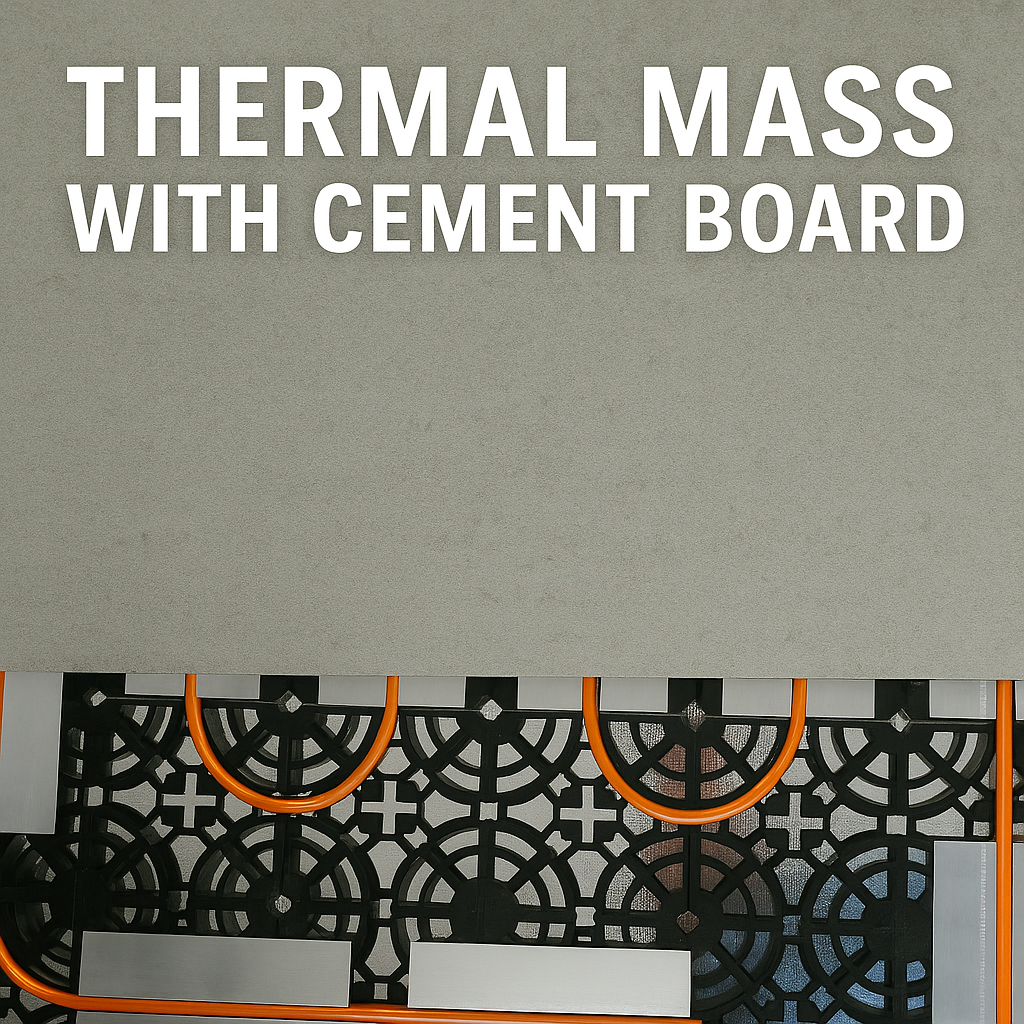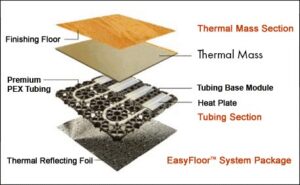Introducing EasyFloor™: The Most Efficient Radiant Heating System for Your Home
Share this story: Facebook X LinkedIn Email Introducing EasyFloor™: The Most Efficient Radiant Heating System for Your Home Are you

Thermal mass refers to a material’s ability to absorb, store, and release heat over time. Think of it as a heat battery—it soaks up warmth from your radiant heating system and gradually releases it, helping maintain stable indoor temperatures and consistent comfort.
In radiant heating, thermal mass isn’t provided by your flooring choice, but rather by a dedicated component built directly into your radiant heating system. At FloorHeat, we recommend a cement board thermal mass layer as a key part of our EasyFloor system. This cement board is strategically installed beneath your flooring, above other essential components like reflective foil, the interlocking grid, PEX tubing, and heat plates.
Why Does Thermal Mass Matter for Radiant Heating?
The goal of installing radiant heating is to deliver steady, comfortable warmth efficiently. Incorporating thermal mass into your radiant system helps achieve this by:
✅ Stabilizing Temperature – Thermal mass captures heat when your system runs and gradually releases it into your space, significantly reducing temperature fluctuations compared to traditional forced-air heating.
✅ Increasing Energy Efficiency – With proper thermal mass, your radiant system operates more smoothly, cycling less often. This reduces energy usage and lowers heating costs.
✅ Enhancing Comfort – A radiant system built with sufficient thermal mass ensures consistent, reliable comfort, even in colder seasons, eliminating rapid temperature changes that can cause discomfort.

How Thermal Mass Allows You Freedom in Flooring Choices
An important benefit of incorporating a dedicated thermal mass layer (like cement board) directly into your radiant heating system is that it enables you to select almost any flooring material you prefer. The cement board provides stable and efficient heat storage and distribution, regardless of the flooring type you choose.
Whether you love hardwood, engineered wood, tile, carpet, or even luxury vinyl planks, a properly designed radiant system with cement board thermal mass ensures your floors stay comfortably warm without compromising performance or efficiency.
Here’s how your radiant system’s thermal mass component complements various flooring choices:
|
Optimizing Your Radiant Heating System with EasyFloor Thermal Mass
To maximize performance and comfort using the EasyFloor radiant heating system with built-in thermal mass, we recommend:
✅ Dedicated Cement Board Layer – Always integrate the cement board layer directly beneath your flooring for maximum heat retention and efficiency.
✅ Choose The Flooring You Prefer – Thanks to the thermal mass layer in your radiant heating system, you don’t have to compromise your flooring selection. You can confidently install carpet, hardwood, vinyl, tile, or concrete—whatever fits your style and needs.
✅ Proper System Insulation – Ensure your radiant system includes high-quality insulation beneath to reduce heat loss and improve overall performance.
✅ Consistent System Operation – Maintain consistent temperature settings for optimal performance and energy efficiency.
A radiant heating system designed with appropriate thermal mass, like FloorHeat’s EasyFloor solution, provides exceptional comfort, energy efficiency, and lasting performance.
Share this story: Facebook X LinkedIn Email Introducing EasyFloor™: The Most Efficient Radiant Heating System for Your Home Are you
Share this story: Facebook X LinkedIn Email Signs Your Radiant Heating System Needs Attention: Troubleshooting Tips and When to Call
Share this story: Facebook X LinkedIn Email Radiant Heating & Sustainability: Why Hydronic Systems Are Eco-Friendly As sustainability and energy
Share this story: Facebook X LinkedIn Email Radiant Heating System Maintenance 101: Keep Your System Running Smoothly A radiant heating
Share this story: Facebook X LinkedIn Email Geothermal Boilers and Radiant Heating – A Perfect Match with FloorHeat EasyFloor
Share this story: Facebook X LinkedIn Email Choosing flooring for your radiant heating system involves balancing aesthetics, performance, and practicality.